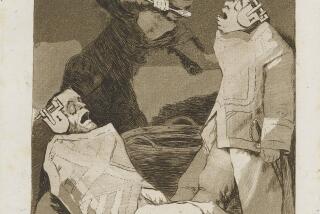ART REVIEWS
Meat and Myth: Ruth Mayerson Gilbert’s black-and-white photographs capture a strangely graceful ballet in which hooded men in flowing robes balance pork and beef carcasses on their shoulders.
Her “Sight Unseen” series, one of three exhibited at Jan Baum Gallery, depicts Parisian deliverers of meat engaged in the simple activities of their daily labor. The 83-year-old’s photographs articulate the repeated gestures of these men as silent rituals in which references to art historical masterpieces, Christian myths and archetypal forms resonate with compelling clarity.
Gilbert’s butchers have the presence of angels. They seem to inhabit a weightless and timeless world in which every one of their movements is guided by a power greater than their own. Their faces, when they are visible, express a trance-like serenity, a sense of self-loss that is both frightening and desirable. These straightforward photographs transform the physical distance between image and viewer into an unbridgeable chasm between this world and the next.
The dramas Gilbert’s subjects act out are, to a large extent, predetermined--not by God, but by the weight of the meat they transport. Part of the magic of her images is the way they find transcendence in the mundane. Their spirituality does not require the denial of worldly existence but emanates from a profound respect for common experiences. Gilbert’s photographs communicate with a visceral directness that engages one’s guts as well as one’s mind.
Details that could be banal are enriched by the patient attention Gilbert pays to subtlety. The quality of light in her images is extraordinary. It endows the natural folds in robes with a sense of inevitability and reflects off monstrous slabs of flesh and cut bones with an inhuman brilliance that acknowledges violence without indulging sensationalism or theatricality.
They also echo iconic scenes from Christian narratives. Bowed figures who bear 10-foot sections of meat on their shoulders offer a contemporary, symbolic rendition of the crucifixion. Other workers who gracefully crouch to lift sides of beef off meat hooks recall the deposition.
Still others evoke Caravaggio’s flamboyant 16th-Century paintings that wildly celebrate the body’s carnality. Some of her photographs give form to the deliberation and restraint embodied by Piranesi’s 18th-Century engravings of prisoners condemned to live in a dark underworld of inescapable suffering.
Gilbert’s two other series make even more direct references to art history. Her “Card Players” portray an array of seemingly ancient men wholly absorbed in their contests against backgrounds of gigantic Italian frescoes depicting classical architecture. Her “In Museum” series catches spectators engaged in various forms of communication with famous paintings. In one photograph, a white-haired man appears to be engaged in a lively conversation with Picasso’s weighty portrait of Gertrude Stein.
While not as daunting as her butchers, these more playful series show Gilbert to be an astute observer, capable of capturing an unforeseen moment in an image whose composure is timeless.
* Jan Baum Gallery, 170 S. La Brea Ave., (213) 932-0170, through March 28. Closed Sundays and Mondays.
More to Read
The biggest entertainment stories
Get our big stories about Hollywood, film, television, music, arts, culture and more right in your inbox as soon as they publish.
You may occasionally receive promotional content from the Los Angeles Times.










